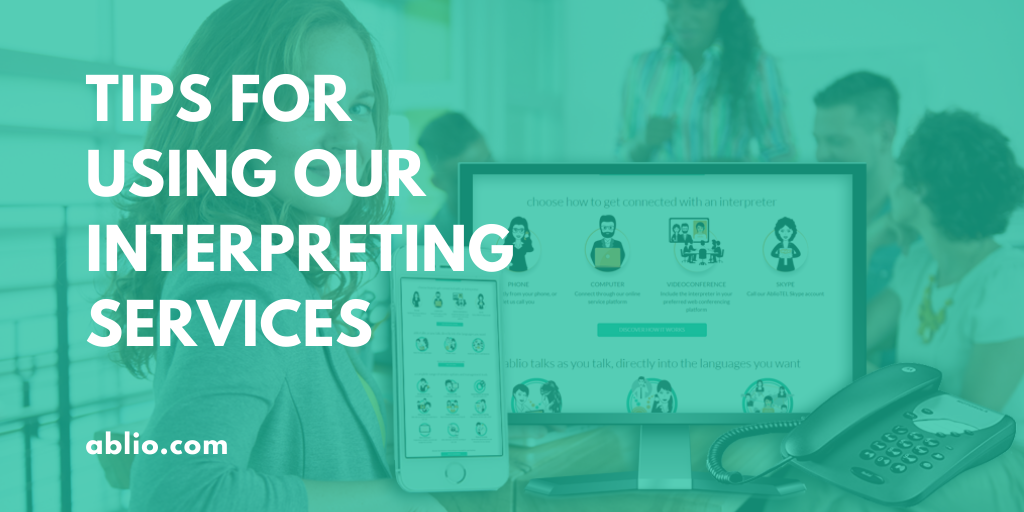Tips for using our interpreting services
Make sure the setting is quiet and communication is clear or try to eliminate any background noise and avoid using speakerphones whenever possible.

PRIOR TO THE CALL
Make sure the setting is quiet and communication is clear
Try to eliminate any background noise and avoid using speakerphones whenever possible. If your counterpart is with you and you are handling the call through the telephone, the optimal solution is to use a dual handset phone for you and your counterpart to connect to the interpreter, listen to the entire conversation flow without the need of passing the handset to each other or using external speakers.
If you are handling the call through your PC using a headset with mic, or the earplugs and mic of your smartphone, you can add a headphone dual adapter to connect another pair of earplugs for your counterpart.
All these devices are cheaply priced and commonly available in any consumer electronics shop. We highly recommend these devices, particularly if you intend to use our services frequently.
DURING THE CALL
Tell the interpreter the context
As soon as you are connected to the interpreter, and before entering into the conversation with your counterpart, take some time to provide the interpreter with some context about the nature of the call, so that they will know what to expect and be better prepared to interpret the call. If you are using some specific terminology, explain and describe it during this initial briefing, to help avoid the need to interrupt the conversation flow to make clarifications.
Explain the interpreter’s role to your counterpart
Once connected to your party, if they are not familiar with an interpreted conversation, you may want to take the time to introduce the interpreter and provide an explanation of the interpreter’s role. You may also clarify both the purpose of the session and the expected outcome. For example, after being connected to your party, you may say “Hi, I have an interpreter, John, on the line. John will be interpreting everything we say to each other, so please address all your comments directly to me, and John will interpret them.”
Incorporate first person or direct speech and address your statements directly to your counterpart. Remember that the interpreter is simply rendering what you say in another language.
Pace your speech
You should speak at a natural pace. However, try to avoid speaking too quickly, as it may be harder for the interpreter to understand you. Also avoid speaking too slowly, as an artificial rhythm can actually detract from the meaning and make the interpreter’s job more difficult. Be aware that if you are reading scripted text that you commonly use, you are likely to speak at a faster pace than normal. In such cases make a conscious effort to slow down your rate of speech.
Talk in short utterances
By pausing frequently to allow the interpreter to render what you have said, you will help to reduce the risk of errors and omissions. A general rule of thumb is to provide one long sentence or three to four shorter ones. Then, you should pause to let the interpreter render the information in the other language. Make sure that you stop in a natural place, such as the end of a sentence. If you stop in the middle of a sentence, the interpreter will often not be able to render it until he or she hears the rest of the sentence.
Enunciate words and speak audibly
Try to pronounce your words clearly and audibly. You may also want to check that the interpreter can hear you clearly. Checking these aspects at the beginning of a call can help prevent requests for repetition or clarification later on in the call, thereby saving you time.
Take turns speaking
It is important that only one party speaks at a time. When multiple parties speak simultaneously, the interpreter will not be able to hear everyone clearly and may lose parts of the meaning. If you notice that your party is interrupting the interpreter, you should direct him or her to wait until the interpreter finishes before interrupting. When all parties take turns speaking in this way, it will allow for the best possible communication, especially if you are dealing with multiple parties.
Ask only one question at a time
It is best not to ask more than one question at once. If you do ask multiple questions at once, you may not be able to match up the answers with the original questions. If you give the interpreter a list of questions to ask, the interpreter will most likely be interrupted by your party, who will want to provide an answer to the questions immediately after each question is asked. This increases the amount of information that the interpreter will have to relay back to you, and therefore increases the chance of information being omitted.
Ensure that your party understands
When you are working through an interpreter, you are less likely to be able to pick up on non-verbal cues such as hesitations, pauses and intonations that might indicate a lack of understanding. It will be helpful for you to verify your understanding, especially regarding the most important pieces of information.
Encourage requests for clarification
If an interpreter stops you to get clarification of something you have said, or to verify accuracy, this is in most cases, a sign of a professional interpreter who is committed to providing an accurate and complete interpretation. If you know that you will be covering highly technical information, you may want to encourage the interpreter to clarify with you if they have any questions or need you to provide an explanation or definition. You may also proactively offer clarifications. In many languages, exact linguistic equivalents may not exist for certain terms. If you provide a definition or explanation of the term when you use it, this will serve to help your counterpart and the interpreter gain a clearer understanding of the message.
Eliminate vague expressions and words that have double meanings
Use descriptive language whenever possible instead of terms that are vague or easily confused. If you use words such as ‘this’ and ‘that’ or ‘here’ and ‘there’, the meaning may not be clear enough. Instead, identify objects and places by name, and be more descriptive when using the telephone interpreter. This is especially important if you are demonstrating something to your counterpart who is present with you.
Notice and work through additional communication problems
Do not automatically assume that a communication barrier or lack of understanding is related to the interpreter’s performance. Just as misunderstandings often take place between two people who speak the same language, they will also sometimes happen when working with an interpreter. If you notice that a response does not seem to relate to what you originally stated, you may want to repeat your original statement in a different way, to make sure that your point is understood. Also, double-check to make sure that you have also understood what your party is trying to convey. Some communication problems go beyond language barriers, and are due to personality issues or differences in communication styles.
Relieve your interpreter as needed
Interpreting is a very demanding activity that is both mentally and physically draining. If a call goes beyond 30 minutes, you may wish to check with the interpreter to see if he or she needs to rest for a minute or two.
A short rest will also allow the interpreter to achieve a greater performance.
AT THE END OF THE CALL
Provide your feedback
After each call you’ll be asked to provide a rating feedback. This will help us to improve our service, provide valuable feedback to the interpreter, and maintain our commitment to provide a service that meets your requirements and expectations.
Using state-of-the-art IT & telecommunication technologies, ablio makes language interpretation services easily available to everyone, in any context, by creating tools and service platforms that are supported by its own community of live interpreters.
For further information please visit our websites:
● ablio.eu – General Website
● ablio.com – OPI Platform
● ablioconference.com – Simultaneous Interpreting Platform

